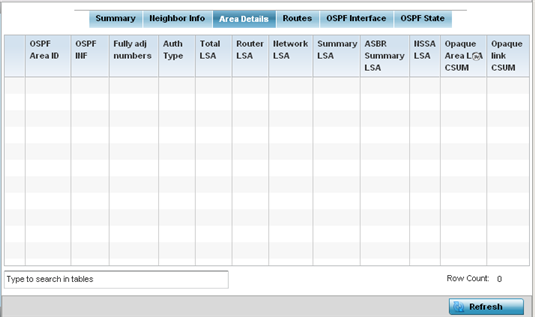OSPF Area Details
An OSPF network is subdivided into routing areas (with 32 bit area identifiers) to simplify administration and optimize traffic utilization. Areas are logical groupings of hosts and networks, including routers having interfaces connected to a network. Each area maintains a separate link state database whose information may be summarized towards the rest of the network. An OSPF Area contains a set of routers exchanging LSAs (Link State Advertisements) with others in the same area. Areas limit LSAs and encourage aggregate routes. Areas are identified by 32-bit IDs, expressed either in decimal, or octet-based dot-decimal notation.
To view OSPF area statistics:
- Select the Statistics menu from the Web UI.
- Expand the RF Domain node.
- Select a Wireless Controller.
- Select OSPF from the left-hand side of the UI.
- Select the Area Details tab.The screen displays.
 This screen provides the following information:
This screen provides the following information:OSPF Area ID Lists the connection request count (hello packets) to connect to the router interface, discover neighbors and elect a designated router.
OSPF INF Lists the interface ID (virtual interface for dynamic OSPF routes) supporting each listed OSPF area ID.
Fully adj numbers Fully adjusted numbers strip away the effects of other non OSPF and LSA factors and events, leaving only relevant OSPF area network route events counted.
Auth Type Lists the authentication schemes used to validate the credentials of dynamic route connections and their areas.
Total LSA Lists the Link State Advertisements of all entities using the dynamic route (in any direction) in the listed area ID.
Router LSA Lists the Link State Advertisements of the router supporting each listed area ID. The router LSA reports active router interfaces, IP addresses, and neighbors.
Network LSA Displays which routers are joined together by the designated router on a broadcast segment (e.g. Ethernet). Type 2 LSAs are flooded across their own area only. The link state ID of the type 2 LSA is the IP interface address of the designated route.
Summary LSA The summary LSA is generated by ABR to leak area summary address info into another areas. ABR generates more than one summary LSA for an area if the area addresses cannot be properly aggregated by only one prefix.
ASBR Summary LSA Originated by ABRs when an ASBR is present to let other areas know where the ASBR is. These are supported just like summary LSAs.
NSSA LSA Routers in a Not-so-stubby-area (NSSA) do not receive external LSAs from Area Border Routers, but are allowed to send external routing information for redistribution. They use type 7 LSAs to tell the ABRs about these external routes, which the Area Border Router then translates to type 5 external LSAs and floods as normal to the rest of the OSPF network.
Redistribution into an NSSA area creates a special type of LSA known as TYPE 7, which can exist only in an NSSA area. An NSSA ASBR generates this LSA, and an NSSA ABR router translates it into type 5 LSA which gets propagated into the OSPF domain.
Opaque Area link CSUM Displays the Type-10 opaque link area checksum with the complete contents of the LSA.
Opaque link CSUM Displays the Type-10 opaque link checksum with the complete contents of the LSA.
- Select Refresh to update the statistics counters to their latest values.



